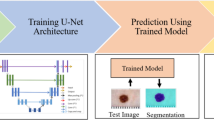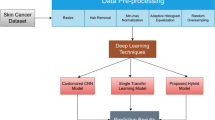Abstract
In this work, we propose a new approach to automatically predict the locations of visual dermoscopic attributes for Task 2 of the ISIC 2018 Challenge. Our method is based on the Attention U-Net with multi-scale images as input. We apply a new strategy based on transfer learning, i.e., training the deep network for feature extraction by adapting the weights of the network trained for segmentation. Our tests show that, first, the proposed algorithm is on par or outperforms the best ISIC 2018 architectures (LeHealth and NMN) in the extraction of two visual features. Secondly, it uses only 1/30 of the training parameters; we observed less computation and memory requirements, which are particularly useful for future implementations on mobile devices. Finally, our approach generates visually explainable behaviour with uncertainty estimations to help doctors in diagnosis and treatment decisions.
Access this chapter
Tax calculation will be finalised at checkout
Purchases are for personal use only
Similar content being viewed by others
References
Bovik, A.C.: The Essential Guide to Image Processing. Academic Press, Cambridge (2009)
Chen, L.C., Papandreou, G., Schroff, F., Adam, H.: Rethinking atrous convolution for semantic image segmentation. arXiv preprint arXiv:1706.05587 (2017)
Chollet, F.: Xception: deep learning with depthwise separable convolutions. In: Proceedings of the IEEE Conference on Computer Vision and Pattern Recognition, pp. 1251–1258 (2017)
Codella, N., et al.: Skin lesion analysis toward melanoma detection 2018: a challenge hosted by the International Skin Imaging Collaboration (ISIC). arXiv preprint arXiv:1902.03368 (2019)
Deng, J., Dong, W., Socher, R., Li, L.J., Li, K., Fei-Fei, L.: ImageNet: a large-scale hierarchical image database. In: 2009 IEEE Conference on Computer Vision and Pattern Recognition, pp. 248–255. IEEE (2009)
He, K., Zhang, X., Ren, S., Sun, J.: Deep residual learning for image recognition. In: Proceedings of the IEEE Conference on Computer Vision and Pattern Recognition, pp. 770–778 (2016)
Huang, G., Liu, Z., Van Der Maaten, L., Weinberger, K.Q.: Densely connected convolutional networks. In: Proceedings of the IEEE Conference on Computer Vision and Pattern Recognition, pp. 4700–4708 (2017)
Koohbanani, N.A., Jahanifar, M., Tajeddin, N.Z., Gooya, A., Rajpoot, N.: Leveraging transfer learning for segmenting lesions and their attributes in dermoscopy images. arXiv preprint arXiv:1809.10243 (2018)
Oktay, O., et al.: Attention U-Net: learning where to look for the pancreas. arXiv preprint arXiv:1804.03999 (2018)
Reddi, S.J., Kale, S., Kumar, S.: On the convergence of Adam and beyond. arXiv preprint arXiv:1904.09237 (2019)
Ronneberger, O., Fischer, P., Brox, T.: U-Net: convolutional networks for biomedical image segmentation. In: Navab, N., Hornegger, J., Wells, W.M., Frangi, A.F. (eds.) MICCAI 2015. LNCS, vol. 9351, pp. 234–241. Springer, Cham (2015). https://doi.org/10.1007/978-3-319-24574-4_28
Siegel, R.L., Miller, K.D., Jemal, A.: Cancer statistics, 2016. CA: Cancer J. Clin. 66(1), 7–30 (2016)
Zhao, H., Shi, J., Qi, X., Wang, X., Jia, J.: Pyramid scene parsing network. In: Proceedings of the IEEE Conference on Computer Vision and Pattern Recognition, pp. 2881–2890 (2017)
Zou, J., Ma, X., Zhong, C., Zhang, Y.: Dermoscopic image analysis for ISIC challenge 2018. arXiv preprint arXiv:1807.08948 (2018)
Author information
Authors and Affiliations
Corresponding author
Editor information
Editors and Affiliations
Rights and permissions
Copyright information
© 2020 Springer Nature Switzerland AG
About this paper
Cite this paper
Nguyen, D.M.H., Ezema, A., Nunnari, F., Sonntag, D. (2020). A Visually Explainable Learning System for Skin Lesion Detection Using Multiscale Input with Attention U-Net. In: Schmid, U., Klügl, F., Wolter, D. (eds) KI 2020: Advances in Artificial Intelligence. KI 2020. Lecture Notes in Computer Science(), vol 12325. Springer, Cham. https://doi.org/10.1007/978-3-030-58285-2_28
Download citation
DOI: https://doi.org/10.1007/978-3-030-58285-2_28
Published:
Publisher Name: Springer, Cham
Print ISBN: 978-3-030-58284-5
Online ISBN: 978-3-030-58285-2
eBook Packages: Computer ScienceComputer Science (R0)




